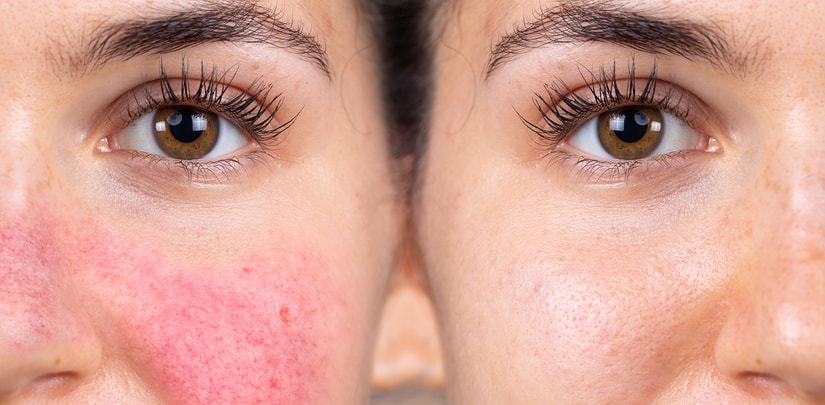Rosacea treatment made great advances in the mid 1980’s when lasers were first used for the most severe cases.
Technology has moved on since those early days and newer treatments using light therapy have been developed which overcome the side effects of the early lasers.
Nowadays Intense Pulsed Light or IPL is considered to be the best treatment for rosacea.
Although lasers and IPL are commonly confused they are very different. They both use light source as the means of treatment but IPL is based on the application of broad bands of pulsating light using an IPL machine with a small hand device. Laser light therapy uses targeted narrow beams of light and is generally less effective for rosacea.
So – why is IPL considered the best way of treating rosacea?
First off the side effects of tissue damage are very much reduced by using IPL for rosacea – assuming of course you have an experienced doctor performing your treatment. IPL is done in office using a hand held device and should be a gentle and non carcinogenic treatment with little or no downtime. The key is to find a good plastic surgeon or qualified dermatologist to perform your procedure – IPL risks include burning and branding of skin caused by over heating the equipment.
With the right physician IPL treatment should give good results for most rosacea sufferers who see a great improvement in symptoms and a reduction in the rate of flare ups.
In fact – as well as treating rosacea – the warming effect of the light energy from the IPL device increases the production of collagen and has a tightening and smoothing effect on the skin.
It is the increase in collagen that supports and heals the tiny blood vessels in your skin. Rosacea symptoms stem from the inflammation of blood vessels so IPL treatment has substantial long term benefits.
Since it’s approval by the FDA in 1995 for the treatment of rosacea – IPL has proved to be very effective. In studies 83% of patients who had IPL treatment reported reduced redness, 75% experienced fewer instances of facial flushing and 64% reported fewer acne type breakouts.

Even more encouraging – if you’re considering this form of treatment – is that it appears to show results quite quickly. Most patients who use IPL notice a reduction in redness and dilated blood vessels after only one or two treatments. Expect around four to six sessions at three to four week intervals for the greatest benefit.
Although IPL is a more gentle form of treatment – for some people there are still some side effects and these can include temporary redness, swelling, bruising, and slight skin lightening. All of which will disappear with the right after care.
The important thing with any treatment of this kind is to choose your IPL doctor carefully and prepare yourself well. Here’s a checklist to help you manage your expectations:
1. Remember there’s no cure for rosacea -dramatic, long lasting results can occur with these treatments, but there is no complete cure for rosacea. You will have to continue to manage your rosacea carefully through adjustments in your lifestyle.
2. You may need more than one course of treatment Your rosacea symptoms may still cause you problems and you may need futher sessions so make sure you are prepared for that outcome.
3. You may not be suitable for treatment – some conditions may make you an unsuitable candidate for IPL therapy. If you have a blood clotting disorder, a tendency towards keloid scarring, or insulin-dependent diabetes you may have an increased risk of infection and less rapid healing after treatment. You need to consult with your doctor and take advice on whether IPL therapy is the best option to treat your rosacea.
4. Pale skin gives best results – light and laser therapy work best for rosacea sufferers with pale skin. Sydney Sweeney and her Skin Care regime are good examples. If you have a sun tan – you need to wait until your skin returns to it’s normal color before going ahead with the treatment. If your skin color is naturally dark you may not get the results you want – talk to the experts at your clinic.
5. Don’t do it if you’re pregnant – effects of IPL treatment on the pregnancy are unknown and it’s safer to avoid all risks.
6. Be realistic about results – IPL may not work for you. Most patients see improvement quickly, but rosacea is as individual as you are and nothing is guaranteed. Skin type, skin color and condition, general lifestyle – all have a bearing on how successful the treatment will be. A specialist dermatologist can help you to determine if IPL is likely to work for your rosacea.
10. Be careful about sun damage – after IPL treatment, your skin will be extremely vulnerable to UV light and you need to wear a high factor sunscreen at all times and keep out of the sun as much as possible.
11. Find a doctor with IPL experience – you need someone who has specific experience with IPL treatment for rosacea. Your dermatologist should be able to recommend the right doctor.
12. Do your due diligence – take time to understand what IPL treatment entails. Visit the office where your IPL treatment will be done and find out exactly what to expect and what you can do to improve the outcome. If you’re fully prepared and get involved in after care management of your rosacea – results will be better.
Most people report very good results but not all of the improvements will show up immediately. You may find that your rosacea symptoms continue to reduce for several weeks after the treatments have been completed.
If you have tiny thread veins as a result of rosacea, for instance, they will take time to disappear. Being dark against the skin – they absorb more light, heat up, and then are broken down and eventually reabsorbed. This process takes time and you’ll need to be patient.
With the right planning, a careful choice of doctor and attention to the correct rosacea after care – you should find that rosacea treatment with IPL is effective and safe.


